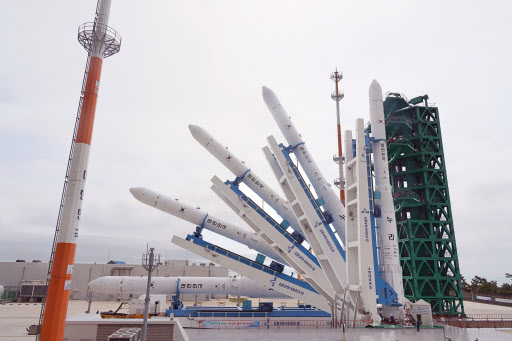South Korea readies second attempt to send homegrown rocket to orbit

Work to erect the Korea Space Launch Vehicle-II (KSLV-II), also called Nuri, is underway for launch at the Naro Space Center in Goheung, South Jeolla Province, Wednesday. (Korea Aerospace Research Institute via The Korea Herald/Asia News Network)
SEOUL — Leaving a major disappointment behind over its first failed attempt last year, South Korea has completed all preparations to send the nation’s first homegrown rocket into orbit, carrying a real satellite designed to send data back to earth.
After eight months improving technical problems involving an early shutdown of the third-stage rocket engine — which was cited as the main cause of the failure in October – the Nuri rocket was once again carried to the launch pad on Wednesday at the state-run space center operated by the Korea Aerospace Research Institute in Goheung, a southern coastal village in South Jeolla Province some 470 kilometers south of Seoul. If the three-stage rocket reaches its target orbit, South Korea will become the seventh country in the world with indigenous capabilities to develop and launch a satellite greater than 1 metric ton.
Instead of loading a dummy satellite, on its second trial Nuri is loaded with a 180-kilogram performance verification satellite that can actually test the rocket‘s capabilities of exploring outer space and sending data to Earth.
The satellite is operated by the country’s three core inventions — the electrically-heated thermoelectric generator, the control moment gyroscope and the S-band antenna.
The generator is basically a heat-generating battery that converts heat flux or temperature differences into electrical power. The control moment gyroscope is a device used to move the satellite in space, after the S-band antenna receives orders from control towers on Earth.
“(If we successfully launch Nuri,) the satellite will explore space for two years. The technologies could be used in the subsequent space programs as well,” said Chang Young-sun, head of the KSLV-II (Nuri) research and development directorate at KARI, during a press conference on Friday.
The satellite also carries four small cube satellites, each weighing between 3.2 – 9.6 kilograms and measuring 30 centimeters in height, developed by four universities — Chosun University, Seoul National University, Yonsei University and the Korea Advanced Institute of Science and Technology.
The four satellites will be released on two-day intervals starting on the eighth day of Nuri’s launch for research purposes, said Ahn Sang-il, senior researcher of at KARI. The satellites cannot be released all at once because this might shake up the performance verification satellite, Ahn added.
Chosun University’s satellite will carry out a mission to detect temperature changes around the Korean Peninsula, while Seoul National University’s satellite plans to collect data of the Earth’s atmosphere. Yonsei University’s and KAIST’s cube satellites will monitor fine dust around the peninsula and compile data on the geographical features of the Earth, respectively.
Project Nuri will be a success if the third-stage rocket reaches an orbit of 700 kilometers above the ground, with error margins of 35 kilometers, according to Chang.
The October launch failed to put the third-stage rocket into orbit because the engine shut down early. The government in December concluded that the loosening of a fixture holding the rocket’s helium tank led to the leakage of oxidizer, a chemical that makes fuel burn.
Learning from the failure, the team behind Nuri made reinforcements on a helium tank anchoring device inside the third-stage oxidizer tank, and applied a thicker manhole cover that closes the oxidizer tank.
Due to the technological tweaks, the weight of the third-stage rocket increased by 9 kilograms — but this hardly affects the launch, Chang explained.
Meaning “world” in Korean, Nuri is a three-stage, liquid-fueled carrier rocket weighing 200 tons and standing 46.2 meters tall. Nuri is developed with exclusively homegrown technologies, unlike the 2018 rocket Naro, which carried Russian-made engines.
Currently, the KARI has completed the transportation of the rocket to the launch pad and held the rocket upright using a launching device. Later in the day, it plans to connect the supply lines of engine fuels and power, and check on any possibility of fuel leakage.
Nuri’s launch has been delayed by one day to Thursday due to windy weather at the launch site.
RELATED STORIES
S. Korea’s Moon vows ‘Korean space age’ after mixed rocket test results
South Korea test-fires first indigenous solid-fuel rocket, pushes to launch spy satellites